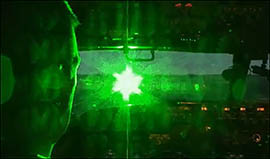Cronkite News has moved to a new home at cronkitenews.azpbs.org. Use this site to search archives from 2011 to May 2015. You can search the new site for current stories.
Lawmaker aims for law against laser strikes on aircraft
PHOENIX – As a Phoenix Police Department helicopter patrolled above north Phoenix the evening of Jan. 21, a green laser aimed from the grounds of a resort hotel illuminated the cockpit with blinding light.
In this case, neither the pilot nor the observer was harmed, and the helicopter helped hotel security apprehend a 36-year-old man who was charged, but officials said it was yet another case of lasers pointed at aircraft endangering pilots’ eyesight and even their lives.
“It’s amazing that people don’t understand that these lasers can blind the pilot and that they’re extremely harmful,” said James Holmes, a police spokesman. “Some think this is a joke or that this is funny and they don’t realize this can cause a major disaster.”
Now a state lawmaker from Tucson is seeking a law specifically banning the practice.
“This may seem like an inconsequential thing from the ground, but it’s a very real public safety issue,” said Rep. Ethan Orr, a Republican.
Orr authored HB 2164, which would build on a state law that makes it illegal to aim a laser pointer at a law officer and carries a misdemeanor. An offense involving an occupied aircraft would be a felony that becomes more severe if a pilot is injured or left unable to operate the aircraft safely.
Laser pointers project a small dot close up, but when viewed at longer distances the beam can be inches across. Advances in laser technology have made pointers more powerful and potentially harmful in recent years, according to Patrick Murphy, editor of the website laserpointersafety.com.
“Lasers have come down in price and gone up in power,” he said. “Higher-power lasers … should be restricted, but this also comes down to there not being one single solution.”
Murphy said warning labels on lasers, which alert users of danger to their eyes, should also note secondary dangers including the danger to aircraft pilots. Meanwhile, he said, training pilots to calmly react when a laser strike occurs, as well as prosecution should be a priority.
Australia banned lasers and put them in the “dangerous weapon” category with crossbows and guns in 2008. Misuse of lasers may result in fines or, in severe cases, up to 14 years in prison.
“In Australia they tried to ban lasers and incidents kept going up anyway,” Murphy said.







